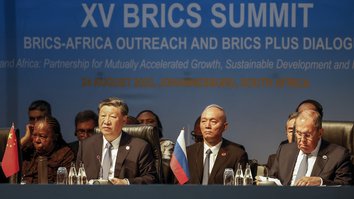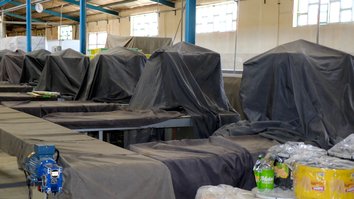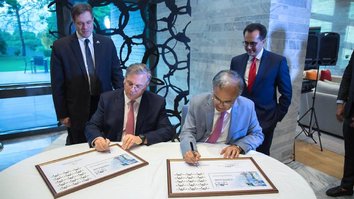PESHAWAR -- Pakistani authorities are reconstructing and rehabilitating militancy-hit tribal areas, aiming to improve the lives of the approximately 4.8m residents of the Federally Administered Tribal Areas (FATA).
During this century, more than 3m of those FATA tribe members had to flee to other parts of Pakistan at some point, as fighting raged between militants and government forces. The government has enabled 80% of those displaced tribe members to go home in recent years.
The government is using the "Build Back Better" approach to reconstruction, with a focus on the Pakistanis hardest hit by the country's on-going war against terrorism, officials say.
Dignified return sought
"The government is implementing a sustainable return and rehabilitation strategy to complement a dignified return of displaced tribe members," Shakil Qadir, former secretary of planning and development for the FATA Secretariat, said in in the secretariat's Rehabilitation and Reconstruction Unit (RRU) annual report for the year 2015-2016, which was issued after the fiscal year began July 1.
"In the new strategy we have used a counter-insurgency lens rather than traditional post-disaster rehabilitation approach and employed different models of R&R [return and rehabilitation] to overcome problems and to serve the crisis victims and survivors," he said.
The resettlement of this large population, which is spread across a vast and diverse region, is no easy task and required insightful planning, political will, extensive co-ordination and substantial support for returning families, said Shakil, who recently became secretary for Home and Tribal Affairs.
"After returning 80% of the more than 3m displaced tribe members to their homes, the government is focusing on reconstruction and rehabilitation of FATA and tribal people," said Nauman Mujahid, deputy director of co-ordination for the Directorate of Projects, FATA Secretariat.
"We set a deadline of November 2016 to complete the process of returning displaced tribesmen, and we have almost achieved our target," he told Pakistan Forward.
"The strategic pillars of the return and rehabilitation strategy include rehabilitating physical infrastructure, strengthening law and order, expanding government service delivery, reactivating the economy and strengthening social cohesion and peace building," he said.
The government has budgeted US $118m (Rs. 12.4 billion) in cash grants for returning tribe members and a number of other sums to help the tribes as part of its Citizen Losses Compensation Programme, he said.
A new era of prosperity
"The developmental projects will pave the way for a new era of economic and social prosperity for tribesmen," KP Governor Zafar Iqbal Jhagra said at a June 9 meeting of the FATA Development Authority in Peshawar.
The tribes made great sacrifices to restore peace, and now the time has come to reciprocate, he said.
"No efforts will be spared to ensure the progress and socio-economic development of tribal areas," he said, calling FATA's economic progress a major government priority.
During the meeting, Jhagra approved seven developmental schemes for FATA costing more than Rs. 2.4 billion (US $25m).
"In January 2015, the RRU initiated a rehabilitation assessment of government infrastructure and public buildings," Shah Nasir Khan, a former infrastructure and resilience specialist in the FATA Secretariat now employed at the World Food Programme, said.
The study encompassed schools, healthcare facilities, power lines and other vital facilities, he told Pakistan Forward.
The government identified 1,406 projects to fix, he said.
"We initiated immediate rehabilitation work before the return of displaced tribesmen to their respective areas to ensure critical facilities are restored," he said.
Large sums for betterment of FATA
In fiscal 2015, the FATA Development Working Party released Rs. 2.3 billion (US $23.1m) and the federal government released Rs. 3 billion (US $30m) to the Pakistani army to perform rehabilitation work in North Waziristan, South Waziristan and Khyber agencies, Shah Nasir said.
Authorities approved another Rs. 1.2 billion (US $12m) worth of development schemes in the Annual Development Plan for 2015-2016, he said.
"The implementation of all these schemes is in progress," he said. "About 400 schemes are completed so far."
A "fast track" approach to rehabilitation and reconstruction in FATA aims to complete the work in 2018, he said.
As a longer-term approach, the FATA Reforms Committee, which has recommended making FATA part of Khyber Pakhtunkhwa Province, has proposed a 10-year development plan for the tribal belt.
The committee has suggested drawing up the 10-year plan by the end of 2016, Sartaj Aziz, adviser on foreign affairs to Prime Minister Mian Muhammad Nawaz Sharif and chairman of the FATA Reforms Committee, told Dawn in August.
Jhagra, the KP governor, will form a committee of specialists and officials to prioritise the plan's development, Sartaj told Dawn, adding that he expects a new era of development after parliament approves the plan.

![KP Governor Zafar Iqbal Jhagra (centre) inaugurates a potable water scheme in Khyber Agency on June 9. Pakistan is focusing on reconstruction and rehabilitation of the terrorism-hit tribal belt. [Courtesy of KP Governor House].](/cnmi_pf/images/2016/11/21/6590-governor-photo-585_329.jpg)






